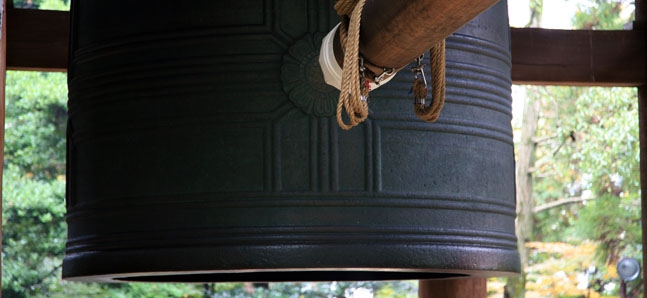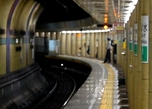
Posted: Wed Dec 29 2010
Ringing out the old year and getting rid of all its baggage with the sound of the joya-no-kane (New Year’s Eve bells) is a traditional way to start the New Year afresh in Japan. Some temples even allow visitors a chance to strike the bonsho (sacred bell) themselves, and, as always, Time Out Tokyo has a top-ten list to set you on your way.
Temples where you can ring out the old year for free
Azabu-san Zenpuku-ji temple
The history of Zenpuku-ji stretches back over 1000 years. Founded by Kobo-daishi (also known as Kukai) in the Heian Period, it was built to encourage the spread of Shingon Buddhism throughout the Kanto region. There are Ginkgo trees in the temple grounds believed to be around 700 years old, and these have been designated natural monuments of Japan. From around 11pm on December 31, visitors begin to line up for the joya-no-kane. There are no limits to visitor numbers, so anyone who lines up can have a chance to toll the bell themselves.
Tsukiji Hongan-ji temple
Tsukiji Hongan-ji is a Jodo Shinshu temple of the Honganji-ha sect, and a branch of Kyoto’s famous Hongan-ji. The main temple building is built in stone and shows the influence of Indian architectural styles - it looks particularly beautiful when it is lit up in the evening. The temple’s honzon (the main object of devotion) is said to have been created by Prince Shotoku himself. For your chance to toll the joya-no-kane at the temple you need one of the numbered tickets which are handed out at the main building until around 11:20pm on New Year’s Eve. You can sound the bell after attending a Buddhist service; the only time of the year when it’s possible for the public at large to get involved.
Horinouchi Myoho-ji
People have been flocking to Myoho-ji since the Edo Period. Known as a temple for yakuyoke – the warding off of evil - the grounds of the temple boast a number of historic structures which have been designated cultural property by the city, or as important cultural property at a national level (look out for the Nio-mon and Tetsu-mon gates, the Onari-no-ma and the Soshi-do). The statues of the kongorikishi guardians, which sit in the left and right sides of the Nio-mon, are thought to have been donated by the fourth Tokugawa shogun, Ietsuna. On New Year’s Eve, you’ll need to line up to experience the joya-no-kane, and the bell can be struck until 2am on New Year’s Day. For the first three days of the year – known as shogatsu sanganichi in Japanese – you can also strike the great bell in the shoro bell tower with the ‘mallet of good luck’ (Yakuyoke Shofuku Uchide no Kozuchi), for even more good fortune in the year to come.
Takahatafudoson Kongo-ji
Situated in an area connected with the Shinsengumi, the well-known Edo Period police force, this is the ancestral temple of one of its members, Toshizo Hijikata, and is one of the three major temples in the Kanto area dedicated to the deity Fudo Myo-o. The colossal Joroku Fudo Sanson scuplture weighs 1100 kilograms and is said to be the biggest of its kind in Japan (yet another important cultural property). To sound the joya-no-kane at Kongo-ji, you need one of the numbered tickets which will be passed out from midday on New Year’s Eve. It’s limited to 108 groups, so you’ll need to get there early.
Honsen-ji
The great bell at Honsen-ji was taken out of the country (nobody is sure why), subsequently found in Geneva, then returned to Japan in 1930. Because this bell (kane in Japanese) was returned, it has also become a symbol of good fortune for returns in terms of money (also kane in Japanese) - a pretty popular bell, then, as far as bell popularity goes. The bell can only be tolled 108 times, but the temple puts visitors into groups and makes sure that everyone can have their chance. There is also a bonfire on the grounds from 11pm, where you can burn old ofuda talismans and omamori charms, as well as everyday items you don’t need anymore, and pray for happiness in the New Year.
Nishiarai Daishi Soji-ji
Soji-ji is commonly known as Nishiarai Daishi, and is a Shingon Buddhist temple. It is said that Kobo-daishi visited the temple to help those suffering from contagious diseases through prayer and healed them with the water that began flowing from a dried-up well. The temple grounds are beautiful, lined with over 20 varieties of ume plum blossoms. The sounding of the joya-no-kane will start at midnight on New Year’s Eve, and as there are no limits to numbers, anyone who lines up can take part for free.
Daihonzan Ikegami Honmon-ji
Honmon-ji is a sacred place where, over 700 years ago, the Buddhist monk Nichiren is said to have died, in 1282, at the age of 60. The temple offers many opportunities to participate in Buddhist religious activities. The teachings of the Lotus Sutra are passed on through the ‘Howa to Shakyo no Kai,’ where participants can attain peace of mind through focusing themselves on Buddhist teachings while quietly copying out sutras. The ‘Senshin Dojo,’ is a two day course of study where you can purify your heart and mind. The joya-no-kane will be struck from 11pm on New Year’s Eve, with numbered tickets being given to the first 600 visitors to arrive at the bell tower. Participation is, of course, free.
Ikosan Homyo-ji
This temple is located a mere 15 minutes from Ikebukuro Station, but has a quietness and tranquillity that makes it hard to believe you are still in the city. It has been revered for its beautiful cherry blossoms since the Edo Period. The temple’s bell is decorated with unusual patterns (an abacus and scales strike us as fairly odd bell decour) and has been designated an important cultural property by Tokyo. On New Year’s Eve, up to 500 people can strike the joya-no-kane for free.
Temples where you can ring out the old year, for a fee
Shibamata Taishakuten (Kyoeizan Daikyo-ji)
This temple is said to have been founded in the Kan’ei era, over 300 years ago. Its grounds are home to the famous Suikeien gardens, a sculpture gallery, and plenty more. The shop that was the model for the kusa-dango shop Tora-san frequents in the Otoko wa Tsurai yo series of films is just by Shibamata Taishakuten’s main gate. Only the first 108 to apply for participation in the first prayers can sound the joya-no-kane, and there is a fee of 15,000 yen. New Year’s Eve talismans, sake cups and Buddhist calendars will be presented in the reception hall, and there will also be taisai talismans and toso spiced sake on offer.
Arai Yakushi Baisho-in
This temple is famous for its omamori charms for curing eye troubles. ‘Me’ is the word for eye in Japanese, and Arai Yakushi Baisho-in’s ema (wooden plaques to write prayers on) are called ‘Meme Ema.’ The character for me is written on the plaques twice, the first one in reverse, to look like a pair of eyes. You can line up for the joya-no-kane from around 11:30pm on New Year’s Eve, and everyone who lines up can have a chance to strike the bell. For the first 108 times, it costs 500 yen, for which you also receive an omamori, and after that visitors can toll the bell for a small donation until 2am.
Daihonzan Zojo-ji
Zojo-ji is one of the seven head temples of Jodo-shu Buddhism. The temple is also home to many historically significant designated cultural properties, on the metropolitan and national level, like the Sangedatsumon gate and the Illustrated Biography of Honen Shonin painted scroll (the Shihon Chakushoku Honen Shonin-den). The temple’s Great Bell is one of the largest in the Kanto area, boasting a height of 2.42 metres. The joya-no-kane will be sounded as the clock strikes midnight on New Year’s Eve by the head priest, and will be the first tolling of the bell for the New Year. Visitors can also strike the bell if they have a special ticket which was available for an offering of 2,000 yen (the tickets for the 2010 New Year were on offer until 9am on Dec 1).
Tweets
- About Us |
- Work for Time Out |
- Send us info |
- Advertising |
- Mobile edition |
- Terms & Conditions |
- Privacy policy |
- Contact Us
Copyright © 2014 Time Out Tokyo











Add your comment